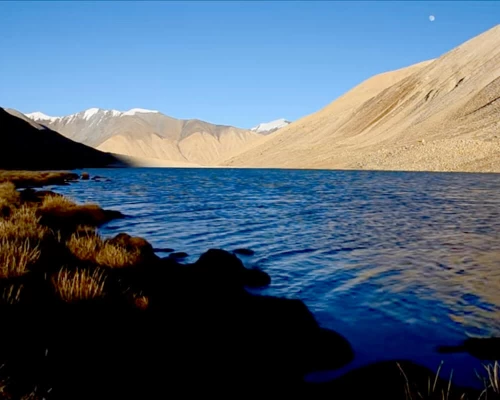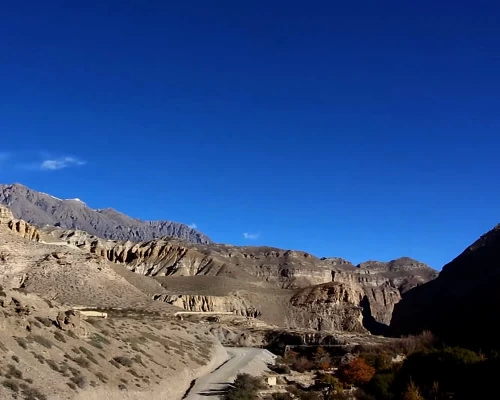The most popular & beautiful places in Upper Mustang Trek
Lo-Manthang
The Mustang will keep on surprising you with its elegance. High walls surround the city of Lo-Manthang, the capital of the upper Mustang on all sides. Along with ancient architecture quaint like Gompas and monasteries, there are many scattered houses. Also, there's a unique village of Tingkhar. Most, importantly Lo-Manthang has a huge palace where the last ascendents of the Mustang kings still live.
Chungsi Cave
Chungsi Cave in the Upper Mustang is a beautiful landmark attached to the cliff. There's a local saying that the stones by which Chungsi cave is formed are actually a back pain medicine. This myth of Ancient Tibetan medication has been accepted by many individuals.
Ghar Gumba
Ghar Gumba is an exciting place to visit in Mustang. This monastery is home to the local monks. Here, they learn the Buddhist values and culture (also known as the Buddhist school). The colorful prayer flags, rotating wheels, and shorts make a wonderful stay in the Ghar Gumba. Also, there are wonderful views of the Himalayan flora.
Choser
Choser lies in the north of Lo-Manthang near Garphu and Nymphu. There are four caves in the Choser area. You can drive Choser via Jeep or on a horse. These caves were built many centuries ago and hold importance among the local people. A $10 permit is needed to visit these caves.
Luri Gumba
Luri Gompa lies a few km away from Mustang in the Saligram River. This Tibetan Buddhist cave is situated near the riverbank. There is an upper prayer room along with a fifteenth-century 'Kabum Stupa.' This was made in the 13th to 14th century when one of the Kings from the Lo-Manthang was married to the Bhutanese princess.
Upper Mustang Permit Cost
Three different kinds of permits are needed to visit the Upper Mustang region.
Permit | Cost | Issue place |
Upper Mustang trek permit | USD 500/ person (10 days) + $50 per day after 10 days | Department of Immigration, Kalikasthan, Kathmandu |
Annapurna conservation area ticket | US $25/ Person | Kathmandu/ Pokhara/ Jomsom |
TIMS card | NRs. 2,000/ person (Group trekker); NRs Rs 2000/ person (solo trekking) | Bhrikutimandap, Kathmandu/ Pokhara |
Most Popular Festivals in Upper Mustang
Tiji Festival (chasing the demons)
The biggest festival of Mustang, Tiji, is three days long celebration in April or May. This colorful festival of Buddhists is celebrated in Lo-Manthang. The purpose of the festival is to pray that peace on Earth prevails. The festival is celebrated to mark the victory of Buddha's incarnation over the demon wreaking havoc in the region during ancient times. During the festival, Buddhist monks in the monastery perform an entertaining dance ceremony.
Yartung Mela (Horse Racing)
During the full moon of August/ September, the Yartung festival is a delight in the Mustang region. This is also a 3-day festival where men and women go for a horse race competition. The king, the monks, and the locals are the center of celebrations. The Gurung and Thakali people community enjoy local foods and drinks. Many foreigners join this festival in Mustang.
Weather and Temperature in Mustang
March to May has a daytime temperature in Mustang of about 14 to 20 degrees Celsius and -5 degrees Celsius at night. Summer is about 25 degrees Celsius, and the nights are also quite warm—the chances of rainfall are minimal in the Monsoon. The Autumn climate in Mustang is about 15 degrees Celsius while nights are below the freezing point (-5 to -2 degrees Celsius). The Winter season has a night temperature of -20 degrees Celsius. The day's temperature is 0 to 5 degrees. In January and December, most of the lower and Upper Mustang areas are covered in snow.
Accommodation During Upper Mustang Trek
Despite being very remote, Upper Mustang thankfully has a handful of great lodges for your stay. The lower area like Jomsom and Kagbeni even has restaurants and bars. Moving to the upper Mustang lodges, we get basic room and food. These tea houses made by locals are a cozy and comfortable place to spend the night.
Food and Beverages
Mustang has excellent choices of meals served in the local tea houses. Besides some national and international cuisine, you can enjoy the local Thakali khana, the best Nepali food which has been loved by the whole country. The other must-try foods in Mustang are a cup of salty tea and local wine made from apples. Dry apricots and apples are also quite delicious.
Guide & Porters
An experienced guide familiar with local culture and language can make your trek very pleasing. A guide helps you get the permit, book flights/ hotels, and find the route. Since Upper Mustang is a remote region, you need to carry everything you might need. Thus, having a porter is very important.
Acclimatization
The highest elevation of the Manthang trek is Lo-Manthang at 3810m. At such a height, the chances of altitude sickness are still high. You might develop altitude sickness in Mustang with symptoms like vomiting, headache, and hard breathing. Since our Itinerary is designed to gain less than 500m each day, you are likely to be okay. Gradually ascending, avoiding high passes, and drinking lots of warm water will be helpful.
Fitness level /Experience
The exciting Trek in Upper Mustang demands 6 to 7 hours of walking per day. Walking over 49 km needs some good physical and mental fitness. Some previous experience with the high-altitude trek is helpful, but even the newbie can easily make it to the top. Cardio-vascular exercises before the trek are very useful.
People and languages in Upper Mustang
Upper Mustang is very sparsely populated with about 2500 individuals. The Thakali, Gurung, and Tamang communities follow their century-old Buddhist tradition. They also speak a unique Tibetan language called Thakali or Thak.





